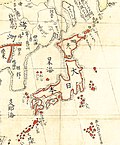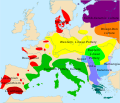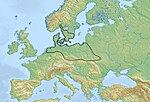Cord-marked pottery or Cordmarked pottery is an early form of a simple earthenware pottery. It allowed food to be stored and cooked over fire. Cord-marked...
10 KB (1,225 words) - 09:27, 14 June 2024
The excavation yielded typical shouldered celts and cord-marked pottery. The cord-marked pottery is a unique characteristic that this site shares with...
5 KB (625 words) - 11:53, 2 January 2024
Paleolithic, around 38–39,000 years ago. The Jōmon period, named after its cord-marked pottery, was followed by the Yayoi period in the first millennium BC when...
137 KB (16,264 words) - 08:35, 20 September 2024
Friedrich Klopfleisch in 1883. He named it after cord-like impressions or ornamentation characteristic of its pottery. The term Single Grave culture comes from...
80 KB (9,123 words) - 06:33, 26 September 2024
with a large variability in dates ranging from 9000 BC to 5500 BC. Cord-marked pottery was discovered among the burial goods. Another important site is...
4 KB (356 words) - 06:06, 2 October 2022
linear-relief, punctated and nail-impressed pottery types. The first cord-marked pottery dates to 8,000 BC. Cord-marked pottery required a technique of pressing...
98 KB (3,918 words) - 19:40, 15 June 2024
to 1000 BCE), is characterized by red-slipped and fine cord-marked pottery similar to the pottery assemblages of prehistoric Taiwan. Phase 2 (1300 BCE to...
23 KB (2,252 words) - 18:47, 24 August 2024
oldest pottery in Japan. Excavations in 1998 uncovered earthenware fragments which have been dated as early as 14,500 BC. The term "Jōmon" means "cord-marked"...
91 KB (11,499 words) - 20:04, 7 August 2024
was discovered in the Penghu Channel c. 2008. Finds of fine red cord-marked pottery at Guoye, Huxi, indicate that Penghu was visited by Austronesians...
62 KB (6,165 words) - 09:33, 20 September 2024
Bell Beaker culture (redirect from Beaker pottery)
the use of the Beaker pottery on the Balearic Islands, between about 2475 and 1300 BC. Some evidence exists of all-corded pottery in Mallorca, generally...
164 KB (19,039 words) - 09:38, 26 September 2024
include beads made of imported turquoise, cord-marked pottery, imported San Lazaro Glaze Polychrome pottery made during the Ancient Pueblo People Pueblo...
6 KB (654 words) - 06:52, 16 July 2024
Jōmon period (section Pottery)
complexity. The name "cord-marked" was first applied by the American zoologist and orientalist Edward S. Morse, who discovered sherds of pottery in 1877 and subsequently...
53 KB (5,972 words) - 05:59, 26 September 2024
red cord-marked pottery, was found in Penghu and the central and southern parts of the western side of the island, and a culture with similar pottery occupied...
25 KB (2,808 words) - 08:20, 26 August 2024
The date of first human settlement is not known. Stone tools and cord-marked pottery dating to between nine thousand and fifteen hundred years ago have...
42 KB (5,088 words) - 22:27, 1 July 2024
Pre-Pottery Neolithic A (PPNA) denotes the first stage of the Pre-Pottery Neolithic, in early Levantine and Anatolian Neolithic culture, dating to c. 12...
15 KB (1,557 words) - 20:58, 13 August 2024
The Pre-Pottery Neolithic (PPN) represents the early Neolithic in the Levantine and upper Mesopotamian region of the Fertile Crescent, dating to c. 12...
19 KB (1,968 words) - 06:00, 11 August 2024
Pre-Pottery Neolithic B (PPNB) is part of the Pre-Pottery Neolithic, a Neolithic culture centered in upper Mesopotamia and the Levant, dating to c. 10...
27 KB (2,833 words) - 03:53, 22 September 2024
examples found at the cave were not cord-marked pottery, but decorated with appliqué of dots or strips of clay. Pottery examined by CT scan found fibers...
13 KB (1,428 words) - 23:24, 17 September 2024
culture's pottery and lithic technology were typical of Late Woodland peoples; earlier generations of the culture seemingly produced cord-marked pottery and...
4 KB (498 words) - 00:13, 14 July 2022
hundred years ago. These consisted of stone tools, spear points, cord-marked pottery, and large cooking hearths. A historical marker was erected in 1947...
14 KB (1,526 words) - 06:31, 6 April 2024
Iznik pottery, or Iznik ware, named after the town of İznik in Anatolia where it was made, is a decorated ceramic that was produced from the last quarter...
54 KB (6,906 words) - 23:52, 31 August 2024
people towards Kansas. Pottery was used for cooking and storage and some of it was decorated. More notable was cord marked pottery that was another influence...
4 KB (514 words) - 15:16, 31 January 2024
agricultural village complex, pottery is a newly defined pottery type now being called Page Plain along with a few sherds of Page Cord-marked ware in very limited...
122 KB (16,896 words) - 18:31, 12 November 2023
Neolithic (redirect from Pottery Neolithic Age)
millennium BC. Early development occurred in the Levant (e.g. Pre-Pottery Neolithic A and Pre-Pottery Neolithic B) and from there spread eastwards and westwards...
78 KB (7,972 words) - 17:38, 9 September 2024
The Linear Pottery culture (LBK) is a major archaeological horizon of the European Neolithic period, flourishing c. 5500–4500 BC. Derived from the German...
76 KB (8,548 words) - 22:33, 14 July 2024
Adena culture (section Pottery)
limestone and was very thick; its decoration was largely plain, cord-marked or fabric marked, although one type bore a nested-diamond design incised into...
18 KB (1,404 words) - 23:07, 4 April 2024
needles are particularly abundant. For the pottery containers, most of them are decorated with cord-marked patterns, and some of them can be seen with...
6 KB (739 words) - 00:01, 5 January 2024
In the early 3rd millennium BCE, the Corded Ware culture appeared in Northern Europe. Its peoples were of marked steppe-related ancestry and traced their...
38 KB (3,931 words) - 00:03, 24 September 2024
Cucuteni–Trypillia culture (category All articles with specifically marked weasel-worded phrases)
million people. The Cucuteni–Trypillia culture had elaborately designed pottery made with the help of advanced kilns, advanced architectural techniques...
104 KB (11,336 words) - 15:01, 19 September 2024
different pottery types. The most common type of pottery during the Hickory Pond period was the Prairie Cord Marked style. The Alachua Cob Marked style became...
8 KB (852 words) - 20:07, 26 August 2024
























